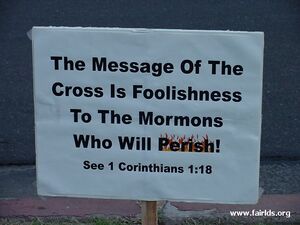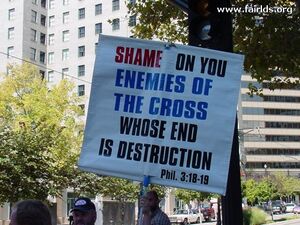
FAIR is a non-profit organization dedicated to providing well-documented answers to criticisms of the doctrine, practice, and history of The Church of Jesus Christ of Latter-day Saints.
(→Statements regarding the atonement: expanded) |
(→Endnotes: expanded) |
||
| Line 83: | Line 83: | ||
#{{note|preach1}} {{PreachMyGospel1|start=32}} {{ia}} {{pdflink|url=http://broadcast.lds.org/Missionary/PreachMyGospel___06_03-1_TheRestoration__36617_eng_006.pdf}} | #{{note|preach1}} {{PreachMyGospel1|start=32}} {{ia}} {{pdflink|url=http://broadcast.lds.org/Missionary/PreachMyGospel___06_03-1_TheRestoration__36617_eng_006.pdf}} | ||
#{{note|true1}} {{TTTF1|article=Atonement of Jesus Christ|start=17}} {{link1|url=http://lds.org/ldsorg/v/index.jsp?vgnextoid=ed462ce2b446c010VgnVCM1000004d82620aRCRD&locale=0&sourceId=8e6e991a83d20110VgnVCM100000176f620a____&hideNav=1&contentLocale=0}} {{ia}} | #{{note|true1}} {{TTTF1|article=Atonement of Jesus Christ|start=17}} {{link1|url=http://lds.org/ldsorg/v/index.jsp?vgnextoid=ed462ce2b446c010VgnVCM1000004d82620aRCRD&locale=0&sourceId=8e6e991a83d20110VgnVCM100000176f620a____&hideNav=1&contentLocale=0}} {{ia}} | ||
{{nw}} | |||
29 Morris, The Cross in the New Testament, 217. | |||
30 Murphy-O'Connor, "Even Death On a Cross," 21-22. H.E.W. Turner wrote 50 years ago that "it still remains true that the monumental genius of St. Paul had little permanent influence on the theology of the early Church." [H.E.W. Turner, The Patristic Doctrine of Redemption. A Study of the Development of Doctrine during the Fist Five Centuries (London: A.R. Mobray, 1952), 24.] After his exhaustive study of 'grace' in the New Testament and the Apostolic Fathers, Thomas Torrance had to conclude that Paul had had almost no influence on them: "The most astonishing feature was the failure to grasp the significance of the death of Christ." He further concludes that "failure to apprehend the meaning of the Cross and to make it a saving article of faith is surely the clearest indication that a genuine doctrine of grace is absent" in the Apostolic Fathers. [Thomas Torrance, The Doctrine of Grace in the Apostolic Fathers (London: Oliver and Boyd, 1948), 137–138.] | |||
31 David D. Garland, One Hundred Years of Study on the Passion Narratives, National Association of Baptist Professors of Religion Bibliographic Series, Vol. 3 (Macon, Georgia: Mercer University Press, 1989), 73–79. More recent commentaries on the relevant verses add significantly to that total. | |||
==Further reading== | ==Further reading== | ||
| Answers portal |
| Jesus Christ |

|
Critics claim that Latter-day Saints teach that the atonement of Christ was carried out in Gethsemane, and not on the cross. They use this as evidence that the Saints are not true Christians, or that they have an "aversion" to the cross.
To see citations to the critical sources for these claims, click here

There is a spectrum of belief in the Church, among both the leaders and the people in the pew, as in all religions. The problem in cases such as this comes when outsiders unconsciously read LDS statements through their own paradigm, and cherry-pick through LDS sermons and scriptures without acknowledging that spectrum of belief.
It is true that members of the Church have historically included the garden of Gethsemane as playing a role in Jesus' saving act. Some have emphasized it, perhaps in reaction to the emphasis on the cross alone in other Christian denominations.
However, even that emphasis, were it the sole message of the Church (and it is not) does not exclude the cross. Note, for example, this excerpt from the Christmas message of Gordon B. Hinckley, past President of the Church:
Other statements by Elder Bruce McConkie, who is sometimes used as evidence for this criticism, show he was not as one-sided as critics imply:
The official training booklet sent out with missionaries includes this statement:
As a fourth example, consider something that recently came from the Church press:
Further, uniquely LDS scripture contains some clear references:

It is worthwhile to note that Latter-day Saints make frequent reference to Christ's sacrifice on the cross in their Sacrament hymns:
These hymns are sung every Sunday as the Sacrament is being prepared. It should be obvious that Jesus' sacrifice on the cross is a central focus.
Many non-LDS Christian theologians and authors have also included Gethsemane in their discussion of Christ's atonement.
For a detailed response, see: Quotes related to the LDS view of the atonement
These statements are not cited in order to devalue in any way the importance of the cross, either for critics or for the Latter-day Saints. It is important to realize however that the cross is not necessarily as significant a concept in the scriptures as they would like it to appear. Leon Morris agrees with Murphy-O'Connor that aside from the writings of Paul, there are not many references in the New Testament to the 'death' of Jesus; indeed: "We would imagine that there are many New Testament references to the death of Christ. But, outside of Paul, there are not."29 And in this context it is important to remember that Paul's writings comprise less than one-fourth of the New Testament writings. Father Murphy-O'Connor also writes "during the first Christian centuries, the cross was a thing accursed. No one professed allegiance to Christ by wearing a cross." He indicates that it was only after Constantine lifted the ban against Christianity in general, and forbade crucifixion in particular, that a "new, more pleasant meaning for the cross was facilitated." But, he concludes, "even after the cross had been widely accepted as a symbol, there was a consistent refusal to accept its reality. Only two crucifixion scenes survive from the fifth century… The situation remains unchanged until the twelfth century."30 These comments are not intended to devalue the cross or the blood shed there, only to place these events in their proper context within sacred scripture. Despite the fact that Gethsemane is mentioned only twice in the scriptures, it has nevertheless engendered an enormous amount of secondary literature. A study on the study of the passion narratives published in 1989 identified seven books dealing specifically with Gethsemane during the previous 100 years and more than 100 articles. That represents a significant amount of discussion on something seemingly of no account!31
These statements from a variety of LDS sources are sufficient to show that the LDS include Christ's suffering and death on the cross as part of his atonement for all humanity. His suffering on the cross was preceded by suffering at Gethsemane.
Even Jesus' life had a part in His atonement, since only God, a perfect being, could perform this service. His mission thus also included being "in all points tempted like as we are, yet without sin" (Hebrews 4:15). It is therefore arbitrary and misleading to draw some type of "line" during Jesus' mortal life or death when He was not working for our salvation. This includes Gethsemane and the cross.
[needs work] 29 Morris, The Cross in the New Testament, 217.
30 Murphy-O'Connor, "Even Death On a Cross," 21-22. H.E.W. Turner wrote 50 years ago that "it still remains true that the monumental genius of St. Paul had little permanent influence on the theology of the early Church." [H.E.W. Turner, The Patristic Doctrine of Redemption. A Study of the Development of Doctrine during the Fist Five Centuries (London: A.R. Mobray, 1952), 24.] After his exhaustive study of 'grace' in the New Testament and the Apostolic Fathers, Thomas Torrance had to conclude that Paul had had almost no influence on them: "The most astonishing feature was the failure to grasp the significance of the death of Christ." He further concludes that "failure to apprehend the meaning of the Cross and to make it a saving article of faith is surely the clearest indication that a genuine doctrine of grace is absent" in the Apostolic Fathers. [Thomas Torrance, The Doctrine of Grace in the Apostolic Fathers (London: Oliver and Boyd, 1948), 137–138.]
31 David D. Garland, One Hundred Years of Study on the Passion Narratives, National Association of Baptist Professors of Religion Bibliographic Series, Vol. 3 (Macon, Georgia: Mercer University Press, 1989), 73–79. More recent commentaries on the relevant verses add significantly to that total.
| FairMormon articles on-line on Jesus Christ |

FAIR is a non-profit organization dedicated to providing well-documented answers to criticisms of the doctrine, practice, and history of The Church of Jesus Christ of Latter-day Saints.
We are a volunteer organization. We invite you to give back.
Donate Now